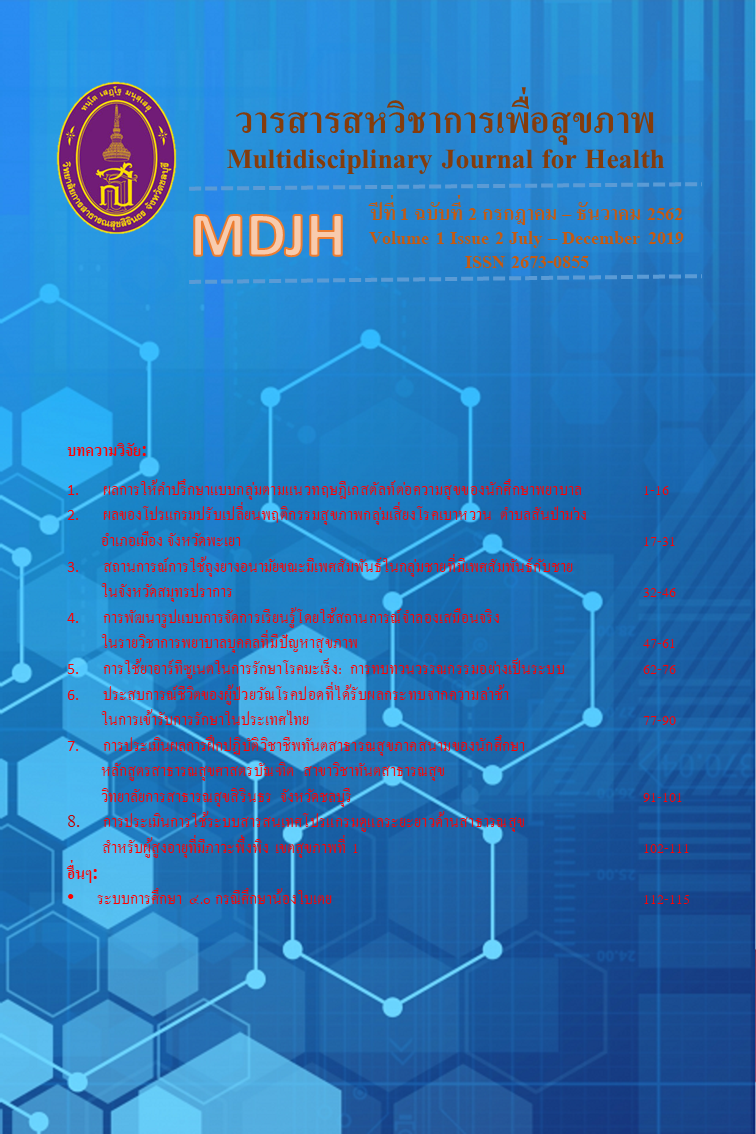การใช้ยาอาร์ทีซูเนตในการรักษาโรคมะเร็ง: การทบทวนวรรณกรรมอย่างเป็นระบบ
คำสำคัญ:
อาร์ทีซูเนต, มะเร็ง, การทบทวนวรรณกรรมอย่างเป็นระบบบทคัดย่อ
การศึกษาโดยวิธีการทบทวนวรรณกรรมอย่างเป็นระบบครั้งนี้ มีวัตถุประสงค์เพื่อศึกษาผลของการใช้ยาอาร์ทีซูเนตในการรักษาโรคมะเร็ง ใช้วิธีการทบทวนวรรณกรรมอย่างเป็นระบบ ตั้งแต่ ปี ค.ศ. 2008 – 2017 จาก 9 ฐานข้อมูลง ผลจากการสืบค้นงานวิจัยที่เกี่ยวข้องโดยใช้การค้นหาจากคำสำคัญ พบว่า มีผลการศึกษาที่ค้นพบซึ่งมีหัวข้อที่เกี่ยวกับยาอาร์ทีซูเนต และโรคมะเร็ง จำนวน 123 เรื่อง เมื่อนำมาวิเคราะห์หาเกณฑ์คัดเข้า และ เกณฑ์คัดออก แล้ว มีการศึกษาที่อยู่ในเกณฑ์คัดเข้าทั้งสิ้น 8 เรื่อง จากฐานข้อมูล PubMed จำนวน 7 เรื่อง และ Science Direct จำนวน 1 เรื่อง ผลการทบทวนวรรณกรรมอย่างเป็นระบบ สามารถสรุปได้ว่ายาอาร์ทีซูเนตสามารถเพิ่มการตายของเซลล์มะเร็งได้ทั้งแบบ มีแบบแผน (Apoptosis) แบบไม่มีแบบแผน (non-apoptotic cell death) และทำให้เกิดการตายเฉพาะส่วน (Necrosis) อกจากนี้พบว่าการรักษาโรคมะเร็งจะได้ผลดียิ่งขึ้นหากใช้ยาอาร์ทีซูเนตร่วมกับการทำเคมีบำบัดด้วย Cisplatin และ Vinorelbine โดยสามารถเพิ่มระยะเวลาของการรอดชีวิตของผู้ป่วยอีกเล็กน้อยและทำให้การเจริญเติบโตของเซลล์มะเร็งช้าลงในขณะที่ผลข้างเคียงของยาชนิดนี้มีเพียงเล็กน้อย
เอกสารอ้างอิง
2. Virani S, Bilheem S, Chansaard W, Chitapanarux I, Daoprasert K, Khuanchana S, et al. National and Subnational Population-Based Incidence of Cancer in Thailand: Assessing Cancers with the Highest Burdens. Cancers (Basel). 2017;9(8).
3. Bayat Mokhtari R, Homayouni TS, Baluch N, Morgatskaya E, Kumar S, Das B, et al. Combination therapy in combating cancer. Oncotarget. 2017;8(23):38022-43.
4. Sliwkowski MX, Mellman I. Antibody therapeutics in cancer. Science. 2013;341(6151):1192-8.
5. Tu Y. The discovery of artemisinin (qinghaosu) and gifts from Chinese medicine. Nat Med. 2011;17(10):1217-20.
6. Chen C, Zheng X. Development of the new antimalarial drug pyronaridine: a review. Biomed Environ Sci. 1992;5(2):149-60.
7. Crespo-Ortiz MP, Wei MQ. Antitumor activity of artemisinin and its derivatives: from a well-known antimalarial agent to a potential anticancer drug. J Biomed Biotechnol. 2012;2012:247597.
8. Wang Q, Wu LM, Li AY, Zhao Y, Wang NP. [Experimental studies of antitumor effect of artesunate on liver cancer]. Zhongguo Zhong Yao Za Zhi. 2001;26(10):707-8, 20.
9. Efferth T, Dunstan H, Sauerbrey A, Miyachi H, Chitambar CR. The anti-malarial artesunate is also active against cancer. Int J Oncol. 2001;18(4):767-73.
10. Wang Q, Wu LM, Zhao Y, Zhang XL, Wang NP. [The anticancer effect of artesunate and its mechanism]. Yao Xue Xue Bao. 2002;37(6):477-8.
11. Cheng C, Ho WE, Goh FY, Guan SP, Kong LR, Lai WQ, et al. Anti-malarial drug artesunate attenuates experimental allergic asthma via inhibition of the phosphoinositide 3-kinase/Akt pathway. PLoS One. 2011;6(6):e20932.
12. Cheng C, Ng DS, Chan TK, Guan SP, Ho WE, Koh AH, et al. Anti-allergic action of anti-malarial drug artesunate in experimental mast cell-mediated anaphylactic models. Allergy. 2013;68(2):195-203.
13. Ho WE, Cheng C, Peh HY, Xu F, Tannenbaum SR, Ong CN, et al. Anti-malarial drug artesunate ameliorates oxidative lung damage in experimental allergic asthma. Free radical biology & medicine. 2012;53(3):498-507.
14. Tan SS, Ong B, Cheng C, Ho WE, Tam JK, Stewart AG, et al. The antimalarial drug artesunate inhibits primary human cultured airway smooth muscle cell proliferation. American journal of respiratory cell and molecular biology. 2014;50(2):451-8.
15. Efferth T, Romero MR, Wolf DG, Stamminger T, Marin JJ, Marschall M. The antiviral activities of artemisinin and artesunate. Clinical infectious diseases : an official publication of the Infectious Diseases Society of America. 2008;47(6):804-11.
16. Schnepf N, Corvo J, Pors MJ, Mazeron MC. Antiviral activity of ganciclovir and artesunate towards human cytomegalovirus in astrocytoma cells. Antiviral research. 2011;89(2):186-8.
17. Li, S. G., Chen, H. Y., Ou-Yang, C. S., Wang, X. X., Yang, Z. J., Tong, Y., & Cho, W. C. (2013). The efficacy of Chinese herbal medicine as an adjunctive therapy for advanced non-small cell lung cancer: a systematic review and meta-analysis. PloS one, 8(2), e57604.
18. Randolph, J. J. (2009). A guide to writing the dissertation literature review. Practical assessment, research & evaluation, 14(13), 1-13.
19. Keele, S. (2007). Guidelines for performing systematic literature reviews in software engineering (Vol. 5). Technical report, Ver. 2.3 EBSE Technical Report. EBSE.
20. Joanna Briggs Institute. (2014). Joanna Briggs Institute reviewers’ manual: 2014 edition. Australia: The Joanna Briggs Institute.
21. Krishna, S., Ganapathi, S., Ster, I. C., Saeed, M. E., Cowan, M., Finlayson, C., ... & Kumar, D. (2015). A randomised, double blind, placebo-controlled pilot study of oral artesunate therapy for colorectal cancer. EBioMedicine, 2(1), 82-90.
22. Zhang, Z. Y., Yu, S. Q., Miao, L. Y., Huang, X. Y., Zhang, X. P., Zhu, Y. P., ... & Li, D. Q. (2008). Artesunate combined with vinorelbine plus cisplatin in treatment of advanced non-small cell lung cancer: a randomized controlled trial. Zhong xi yi jie he xue bao= Journal of Chinese integrative medicine, 6(2), 134-138.
23. Zhang, P., Luo, H. S., Li, M., & Tan, S. Y. (2015). Artesunate inhibits the growth and induces apoptosis of human gastric cancer cells by downregulating COX-2. OncoTargets and therapy, 8, 845.
24. Hamacher-Brady, A., Stein, H. A., Turschner, S., Toegel, I., Mora, R., Jennewein, N., ... & Brady, N. R. (2011). Artesunate activates mitochondrial apoptosis in breast cancer cells via iron-catalyzed lysosomal reactive oxygen species production. Journal of Biological Chemistry, 286(8), 6587-6601.
25. Du, J. H., Zhang, H. D., Ma, Z. J., & Ji, K. M. (2010). Artesunate induces oncosis-like cell death in vitro and has antitumor activity against pancreatic cancer xenografts in vivo. Cancer chemotherapy and pharmacology, 65(5), 895-902.
26. Berdelle, N., Nikolova, T., Quiros, S., Efferth, T., & Kaina, B. (2011). Artesunate induces oxidative DNA damage, sustained DNA double-strand breaks, and the ATM/ATR damage response in cancer cells. Molecular cancer therapeutics, 10(12), 2224-2233.
27. Michaelsen, F. W., Saeed, M. E., Schwarzkopf, J., & Efferth, T. (2015). Activity of Artemisia annua and artemisinin derivatives, in prostate carcinoma. Phytomedicine, 22(14), 1223-1231.
28. Rasheed, S. A. K., Efferth, T., Asangani, I. A., & Allgayer, H. (2010). First evidence that the antimalarial drug artesunate inhibits invasion and in vivo metastasis in lung cancer by targeting essential extracellular proteases. International journal of cancer, 127(6), 1475-1485.
29. Efferth, T., Giaisi, M., Merling, A., Krammer, P. H., & Li-Weber, M. (2007). Artesunate induces ROS-mediated apoptosis in doxorubicin-resistant T leukemia cells. PloS one, 2(8), e693.
30. Efferth, T., Dunstan, H., Sauerbrey, A., Miyachi, H., & Chitambar, C. R. (2001). The anti-malarial artesunate is also active against cancer. International journal of oncology, 18(4), 767-773.
31. Bachmeier, B., Fichtner, I., Killian, P. H., Kronski, E., Pfeffer, U., & Efferth, T. (2011). Development of resistance towards artesunate in MDA-MB-231 human breast cancer cells. PLoS One, 6(5), e20550.



